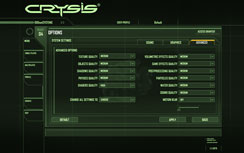Crysis
Publisher: Electronic ArtsWhat can we say about this game that hasn't been said already? Crysis was probably the most anticipated game on the PC last year and was released on November 16th 2007.
Crysis is seen by many as the poster boy for DirectX 10 and it will make your system cry, quite literally – it's a monster! It doesn't come as much of a surprise then, that the graphics are something special – they're above and beyond anything we've ever seen before in a PC game.
We tested the game under both DirectX 9.0 and DirectX 10 with the 1.1 patch applied. We used a custom timedemo recorded on the Harbor map which is more representative of gameplay than the built-in benchmark that renders things much faster than you're going to experience in game. We found that around 30 fps in our timedemo was sufficient enough to obtain a playable frame rate through the game. It's a little different to other games in that the low frame rates still appear to be quite smooth.
For our testing under both DirectX 9.0 and DirectX 10, we set the majority of the in-game settings to medium, with shaders and sound set to high. Because of how intense the game is, we tested with both anti-aliasing and anisotropic filtering disabled on these mid-range cards – but of course, you can enable AA if you want to sacrifice some other in-game details in order to get a playable frame rate. There is currently no support for anisotropic filtering in the game, but you can still force it from the driver control panel.
DirectX 9.0
DirectX 10
The GeForce 9600 GT in its reference form manages to perform pretty well compared to the competition from AMD until you get to 1680x1050 under DirectX 10 mode, where it falls behind PowerColor's pre-overclocked Radeon HD 3850 512MB card. In DirectX 9.0 mode at the same settings and resolution, the GeForce 9600 GT sits right next to the Radeon HD 3870 on the bench, but then PowerColor's HD 3850 isn't exactly far behind either.
The difference between the reference GeForce 9600 GT and PowerColor's card is just 0.8 frames per second or 2.6 percent – otherwise known as completely indistinguishable to most of us. What is noticeable in the real world though is the impact on your wallet.
Zotac's factory overclocked card impresses more with excellent performance that almost rivals the GeForce 8800 GT in DirectX 9.0, it does so at a good price, too. Performance also drops off a little when you use DX10, with the gap opening out to around 10 percent at both 1280x1024 and 1680x1050.

MSI MPG Velox 100R Chassis Review
October 14 2021 | 15:04











Want to comment? Please log in.